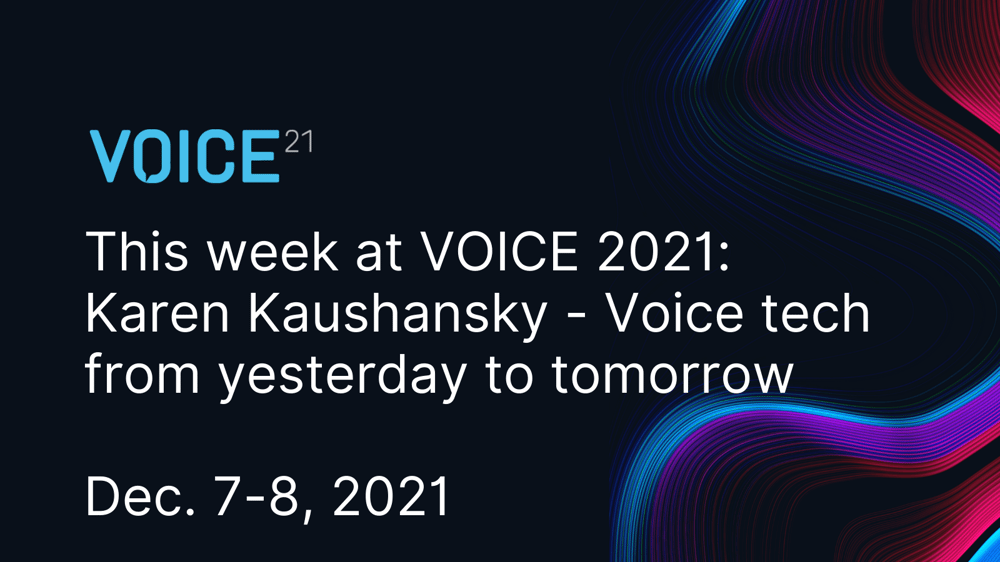Karen Kaushansky - Voice tech from yesterday to tomorrow
VOICE Summit 21-12-7 Modev Staff Writers 3 min read

Karen Kaushansky is a Senior Conversation Designer at Google. She started designing voice interfaces in 1996 and has spent 25 years designing experiences shaping our interactions with the world. Karen's work spans designing conversational interfaces, enterprise chatbots, smart clothing, natural interactions in mixed reality, and experiences for passengers and pedestrians with autonomous vehicles.
Karen will be joining us at VOICE 2021, taking place both in-person in Arlington, Va. and virtually, Dec. 7-8. She will discuss the lessons she learned during her 25 years in conversational design and look to the future to provide insights on where she feels the technology is headed. And as you may have gathered from the little intro above, her design experience is quite extensive. It's more than likely that you'll get some invaluable takeaways from hearing her speak.
Memory lane
Kaushansky is aware that it may surprise more than one that she started designing voice interactions in 1996. After all, nobody had a voice assistant back then. But as with all technology, we tend to wake up to it once it comes to market. And we don't think about the fact that the tech we have in our hands took years - perhaps even decades - to come to fruition. We also forget the less sophisticated "stepping stone" experiences we've had before, which ended up being evolutionary prototypes of what we use today.
Case in point: Kaushansky will make you remember voice dialers, which she's designed. These were one of the first voice experiences offered to consumers, among other forgotten voice tech.
As she looks to the last 25 years of voice interaction design, she will highlight some of the successes and failures (we learn from those too) from voice tech design's history that has made conversational AI what it is today. Peppered throughout that history, you'll hear about some of the voice tech from yesteryears that you may have forgotten. Beyond that, Kaushansky will provide real-world examples that embody the evolution and design of voice interactions and share the lessons she learned, their implications, and the change of direction they imposed. And as is often the case when we take a look back, Kaushansky makes the point that the design learnings she picked up over the years are even more relevant today - not less.
On top of that, you're sure to hear some interesting anecdotes as she takes us on that journey.
Turning to the future
Having been involved with voice tech for so long can give one a bit of an edge in providing an educated guess on its future. Just as Kaushansky looks back at the last 25 years of voice interaction design, she can look 25 years ahead and share her view on the tech's future with us.
Drawing upon such an extensive background all but guarantees these are not wild guesses. Kaushansky's experience and observations inform her insights into the tech's future. Looking into the future of voice tech, Kaushansky will discuss things like app fatigue (the fact that we often need multiple apps to achieve a single task) and the rise of the chatbot. She will discuss the fact that vocal assistants increasingly interact with other vocal assistants on behalf of customers and point to the advent of mixed reality characters capable of inducing emotional connections, among other things. What threads all of these elements together is her two-fold view of the future of voice tech:
- Interface interactions - enhancing the capacity for natural conversational requests and deep-linking into apps.
- Relationship building - moving toward entire conversations with characters (avatars) capable of emotional recognition.
And both of these lead us towards Kaushansky's vision of the future: an app-less world: a world where you can just cut through the noise and get to what you want without fuss - and without needing multiple apps to get there.
As she says, "Voice is the key to that app-less world. Voice is what can work across all of these different apps to get an answer. I don't want to download and install a BMW app, a calendar app, and a mechanics app. I want to ask when is a good time to bring my car in for servicing. Voice and other inputs are the controllers to create the realities that users want. And those realities can be created through interaction with characters that are capable of emotional awareness, making the interactions more real, and creating some amazing experiences."
Hear Karen Kaushansky speak about voice tech’s past, present, and future at VOICE 2021 this week. View the schedule and join VOICE 2021 - the only conversation poised to shape the future of conversational AI, taking place both in-person in Arlington, Va. and virtually, Dec. 7-8.